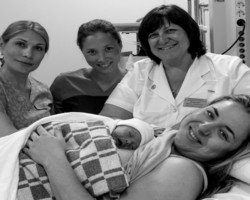Experts address alarming increase in caesarean sections at meeting in Tbilisi, Georgia

Member States, policy-makers and experts from 19 countries gathered at a WHO meeting in Tbilisi, Georgia, to agree on how to reduce unnecessary caesarean sections (C-sections) in the WHO European Region.
The use of C-sections to deliver babies has increased dramatically over the past 20 years and, according to doctors, is reaching epidemic proportions. Unbiased, evidence-based information is needed to guide women and obstetricians to optimize their use of C-sections.
Dr Nino Berdzuli, Programme Manager for Sexual and Reproductive, Maternal and Newborn Health at WHO/Europe, opened the meeting by clearly stating the challenge: “The operation is vital when complications occur during pregnancy and birth, but once caesarean section rates are above 10–15%, there is no evidence to suggest that the procedure helps reduce maternal and newborn mortality. On the contrary, the surgery can lead to complications and should be conducted when medically necessary.”
Presentations from countries across the Region revealed enormous differences in C-section rates – from 7% to 51% – with worrying trends. While national rates for C-sections between 2010 and 2015 remained below 20% in parts of northern Europe, they increased to 50% and over in several countries in south-eastern Europe.
These striking differences in C-section rates across Europe raise questions about their impact on short-term, but also longer-term, maternal and child health. They also underscore differences in the approaches that countries of Europe have taken to managing childbirth.
Mothers often unaware of risks
For mothers, the negative consequences of C-sections for future pregnancies include an increase in spontaneous preterm birth, uterine rupture and abnormal placentation that may result in excessive maternal bleeding and often the need for hysterectomy.
For infants, C-sections are associated with risks that mothers are not always aware of, including increased likelihood of:
- admission to neonatal intensive care units;
- neonatal depression due to general anaesthesia;
- respiratory distress, even at term;
- higher likelihood of breastfeeding complications;
- asthma; and
- obesity.
Researchers have also found that higher national rates for C-sections do not ensure that the procedure is provided to all women in need. This is especially true in rural areas, partly due to the absence of facilities and a lack of adequate skills.
Misconception and convenience main reasons for choosing C-sections
The following reasons for increasing C-section rates are repeatedly reported in studies from many countries:
- fear of pain;
- concerns about genital modifications after vaginal delivery;
- the misconception that a C-section is safer for the baby;
- convenience for health professionals and for the mother and family;
- misaligned financial incentives with higher reimbursement for C-sections than for vaginal deliveries;
- fear of medical litigation; and
- lower tolerance for any complications or temporary aesthetic imperfections from the baby’s passage through the birth canal.
For many years, doctors have elected to administer C-sections because they are easier to plan. This makes them more convenient for doctors and mothers, particularly when compared with unscheduled and often lengthy instrumental deliveries.
However, overreliance on C-sections presents issues for medical education: it can lead to a lack of training in the clinical skills necessary to manage complications during instrumental delivery, with corresponding concerns over legal issues.
“Increased use of caesarean sections also adds an unnecessary financial burden on health systems,” Dr Berdzuli stated. “Medically unnecessary caesarean sections are not an efficient use of limited health-care resources. There is a need to develop policies that encourage health-care organizations to provide value-based and cost-effective care.”
Factors associated with higher rates of vaginal deliveries may include strict policies on maternal requests for C-sections, cultural or social pressure, differences in the legal framework for medical litigation, and strategies favouring home births or a midwifery-led approach to births.
Benefits of vaginal delivery little known
The benefits of vaginal delivery to the fetus have been studied, and one specific advantage in particular – maternal vaginal microbiota – was recently identified. Vaginal delivery exposes infants to microbes colonizing the mother’s birth canal that have the potential to impact physical and neurocognitive development and life-course disease risk. Together with exclusive breastfeeding, this influences the maturation of the infant immune system and health during the first 1000 days of life.
The challenge remains for countries to identify the reasons for high rates of C-sections in their national contexts, and to consider how to shift C-sections from being the normal way of giving birth to being procedures only undertaken when medically necessary.
WHO recently launched guidelines for reducing unnecessary C-sections that have formed the basis for discussions. With the support of partners, WHO will facilitate the way forward, refine advocacy and empower women to increase their health literacy.
The meeting in Tbilisi closed with a call to action and the presentation of key action points at country, regional and global levels.



